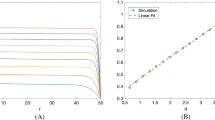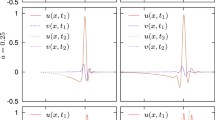Abstract
We investigate the response of a system far from equilibrium close to an oscillatory instability to the induction of phase singularities. We base our investigation on a numerical treatment of the complex Ginzburg–Landau equation (CGLE) in two spatial dimensions, which is considered as an order-parameter equation for lasers and other nonlinear optical systems. Defects are randomly generated by a spatially modulated linear growth rate. In the amplitude-turbulent regime, no qualitative change of behaviour can be detected. Phase-turbulent patterns emerging due to the Benjamin–Feir instability are destroyed by the externally injected defects. One observes either states consisting of spiral structures of various sizes which resemble the vortex glass states of the unperturbed system or a travelling wave pattern containing moving topological defects. In parameter space, both states are separated by a well-defined phase boundary which is close to the line separating convectively from absolutely stable travelling waves.
Similar content being viewed by others
References
Arecchi FT, Boccaletti S, Ramazza PL (1999) Phys. Rep. 318:1
Lugiato LA, Brambilla M, Gatti A (1999) Adv. At. Mol. Opt. Phys. 40:229
Ikeda K, Daido H, Akimoto O (1980) Phys. Rev. Lett. 45:709
Moloney JV (1984) Phys. Rev. Lett. 53:556
Akhmanov SA, Vorontsov MA, Ivanov VY (1988) Sov. Phys. JETP 47:707
D’Alessandro G, Firth WJ (1992) Phys. Rev. A 46:537
D’Angelo EJ, Green C, Tredicce JR, Abraham NB, Balle S, Chen Z, Oppo GL (1992) Physica D 61:6
Neubecker R, Tschudi T (1994) J. Mod. Optic. 41:885
Ackemann T, Logvin Y, Heuer A, Lange W (1995) Phys. Rev. Lett. 75:3450
Arecchi FT, Larichev AV, Ramazza PL, Residori S, Ricklin JC, Vorontsov MA (1995) Opt. Commun. 117:492
Huyet G, Rica S (1996) Physica D 96:215
Mitschke F, Steinmeyer G, Schwache A (1996) Physica D 96:251
Hochheiser D, Moloney JV, Lega J (1997) Phys. Rev. A 55:R4011
Mamaev AV, Saffman M (1998) Phys. Rev. Lett. 80:3499
Farjas J, Hennequin D, Dangoisse D, Glorieux P (1998) Phys. Rev. A 57:580
Aumann A, Ackemann T, Große Westhoff E, Lange W (2001) Int. J. Bifurcat. Chaos 11:2789
Gomila D, Colet P (2003) Phys. Rev. A 68:011801(R)
Madelung E (1926) Z. Phys. 40:322
Coullet P, Gil L, Rocca F (1989) Opt. Commun. 73:403
Brambilla M, Battipede F, Lugiato LA, Penna V, Prati F, Tamm C, Weiss CO (1991) Phys. Rev. A 43:5114
Staliunas K (1993) Phys. Rev. A 48:1573
Weiss CO, Vaupel M, Staliunas K, Slekys G, Taranenko VB (1999) Appl. Phys. B 68:151
Graham R, Haken H (1970) Z. Phys. 237:31
Frisch M (1995) Turbulence. Cambridge University Press, Cambridge
Ackemann T, Lange W (2001) Appl. Phys. B 72:21
Haken H (2004) Synergetics: Introduction and Advanced Topics. Springer, Berlin Heidelberg New York
Kuramoto Y (1984) Chemical Oscillations, Waves and Turbulence. Springer, Berlin Heidelberg New York
Manneville P (1990) Dissipative Structures and Turbulence. Academic, San Diego, CA
Cross MC, Hohenberg PC (1993) Rev. Mod. Phys. 65:861
Staliunas K, Tarroja MFH, Slekys G, Weiss CO (1995) Phys. Rev. A 51:4140
Aranson IS, Kramer L (2002) Rev. Mod. Phys. 74:99
Chaté H, Manneville P (1996) Physica A 224:348
Huber G, Alstrom P, Bohr T (1992) Phys. Rev. Lett. 69:2380
Bohr T, Huber G, Ott E (1996) Europhys. Lett. 33:589
Bohr T, Huber G, Ott E (1997) Physica D 106:589
Staliunas K, Slekys G, Weiss CO (1997) Phys. Rev. Lett. 79:2658
Author information
Authors and Affiliations
Corresponding author
Additional information
PACS
47.54.+r; 89.75.Kd; 42.65.Sf; 47.32.Cc; 47.27.Cn; 05.45.-a
Rights and permissions
About this article
Cite this article
Zhao, H., Friedrich, R. & Ackemann, T. On the response of an oscillatory medium to defect generation. Appl. Phys. B 81, 969–973 (2005). https://doi.org/10.1007/s00340-005-2014-z
Received:
Revised:
Published:
Issue Date:
DOI: https://doi.org/10.1007/s00340-005-2014-z




